Flexural Performance of Removable Deck Slabs with Fixing Device Details
Abstract
:1. Introduction
2. Research Significance
3. Fixing Device of a Removable Deck Plate
3.1. Details of Fixing Device
3.2. Finite Element Analysis for Fixing Device
3.3. Anchoring Performance Evaluation of Fixing Device
3.3.1. Test Plan and Specimen Detail
3.3.2. Test Results of Anchorage Performance of the Fixing Device
4. Safety Evaluation of Removable Deck Plates during Construction
4.1. Construction Load Test Plan
4.2. Construction Load Test Results
4.2.1. Load–Displacement Relationship
4.2.2. Load–Strain Relationship
5. Flexural Performance of Reinforced Concrete Deck Slab
5.1. Construction Load Test Plan
5.2. Material Test Results
5.3. Flexural Performance Test Results
5.3.1. Load–Displacement Relationship and Crack Pattern
5.3.2. Load-Strain Relationship
6. Conclusions
- (1)
- The anchorage performance test of the fixing device showed that the IR test specimen exhibited 7% to 25% greater ultimate strength compared with the R and RP types, making it the most effective shape. The improvement of the cross-sectional shape enabled structural performance improvement and steel thickness reduction.
- (2)
- A deflection test for construction determined that the maximum spacing of the fixing device should be less than 300 mm when considering design safety. Staggered placement at 300 mm intervals is recommended as the deflection during construction can be reduced if staggered arrangement is performed rather than in line arrangement. This suggests a need to secure a sufficient safety factor for detailed devices in the entire deck plate in case of sagging, particularly in places where there is a concern about concentrated loads by casting load and equipment in future design and on-site construction.
- (3)
- The strain of the fixing device in the flexural performance test was found to be in an elastic state, while all reinforcing bars yielded before maximum strength were reached and exhibited sufficient deformation. The installation method and spacing of the fixing device, therefore, have little to do with bending performance.
- (4)
- The FEA performed in this study was used only as a tool to set the experimental parameters. Although the most effective shape was found through the experimental results, finite element analysis under various conditions, such as thickness, width, and curvature, for shape optimization was not performed. Therefore, future studies should apply finite element analysis to various variables based on the experimental results to identify the optimal height and width of IR-type ribs so that the experimental results can be generalized.
Author Contributions
Funding
Institutional Review Board Statement
Informed Consent Statement
Data Availability Statement
Conflicts of Interest
References
- Son, D.H.; Bae, B.I.; Lee, M.S.; Lee, M.S.; Choi, C.S. Flexural Strength of Composite Deck Slab with Macro Synthetic Fiber Reinforced Concrete. Appl. Sci. 2021, 11, 1662. [Google Scholar] [CrossRef]
- Langarudi, P.A.; Ebrahimnejad, M. Numerical Study of the Behavior of Bolted Shear Connectors in Composite Slabs with Steel Deck. Structures 2020, 26, 501–515. [Google Scholar] [CrossRef]
- Subhani, M.; Kabir, M.I.; Al-Ameri, R. Strengthening of Steel-Concrete Composite Beams with Composite Slab. Steel Compos. Struct. 2020, 34, 91–105. [Google Scholar]
- Bae, K.W.; Lee, S.S.; Park, K.S. An Experimental Study on the Flexural Behavior for the Slabs Using the Suspending Deck Plate. J. Korean Soc. Steel Constr. 2013, 25, 25–34. [Google Scholar] [CrossRef] [Green Version]
- John, K.; Ashraf, M.; Weiss, M.; Al-Ameri, R. Experimental Investigation of Novel Corrugated Steel Deck under Construction Load for Composite Slim-Flooring. Buildings 2020, 10, 208. [Google Scholar] [CrossRef]
- Hong, E.-A.; Chung, L.; Paik, I.-K.; Yun, S.-H.; Cho, S.-H. Structural Performance and Usability of Void Slab Established in T-deck Plate. J. Korea Concr. Inst. 2012, 24, 677–684. [Google Scholar] [CrossRef] [Green Version]
- Lee, J.-E.; Kim, B.-Y.; Jung, B.-J. Evaluation of Structural Safety and Economic Feasibility for Removable Steel Plate Eco Deck Plate. J. Archit. Inst. Korea Struct. Constr. 2014, 30, 3–10. [Google Scholar]
- Lee, H.-J.; Yang, K.-H.; Kim, S.; Hong, J.-K.; Kim, D.-H.; Mun, J.-H. Deflection Test of Wire-Integrated Steel Deck Plates with Various End Details. Materials 2023, 16, 2251. [Google Scholar] [CrossRef] [PubMed]
- Kim, S.B.; Kang, M.J.; Kim, S.S. An experimental study on structural performance evaluation of steel wire-integrated deck plate. Int. J. Steel Struct. 2015, 15, 945–958. [Google Scholar] [CrossRef]
- Shin, J.; Lee, J.; Lee, Y.; Kim, B. Experimental and Numerical Investigation on Structural Performance of Steel Deck Plate Bolted with Truss Girder. Appl. Sci. 2019, 9, 3166. [Google Scholar] [CrossRef] [Green Version]
- MIDAS IT. MIDAS/FEA Users Manual; MIDAS IT: Seongnam-si, Republic of Korea, 2015. [Google Scholar]
- Korean Agency for Technology and Standards. KS D 3861; Rolled Steels for Building Structures. Korean Agency for Technology and Standards: Seoul, Republic of Korea, 2021; pp. 1–19.
- Park, J.H. Nonlinear Finite Element Analysis of Prestressed Composite Beams with Discontinued Webs. Master’s Thesis, University of Seoul, Seoul, Republic of Korea, 2013. [Google Scholar]
- Earij, A.; Alfano, G.; Cashell, K.; Zhou, X.M. Nonlinear three-dimensional finite-element modelling of reinforced-concrete beams: Computational challenges and experimental validation. Eng. Fail. Anal. 2017, 82, 92–115. [Google Scholar] [CrossRef]
- Genikomsou, A.S.; Polak, M.A. Finite element analysis of punching shear of concrete slabs using damaged plasticity model in ABAQUS. Eng. Struct. 2015, 98, 38–48. [Google Scholar] [CrossRef]
- Ministry of Land, Infrastructure and Transport. KDS 21 50 00; Formwork and Shoring Design Code. The Korea Communications Standards Commission: Seoul, Republic of Korea, 2022. (In Korean)
- Ministry of Land, Infrastructure and Transport. KDS 14 20 00; Structural Concrete Design Cosede. The Korea Communications Standards Commission: Seoul, Republic of Korea, 2022. (In Korean)
- Korean Agency for Technology and Standards. KS F 2403; Standard Test Method for Making Concrete Specimens. Korean Agency for Technology and Standards: Seoul, Republic of Korea, 2019; pp. 1–8. (In Korean)
- Korean Agency for Technology and Standards. KS B 0802; Method of Tensile Test for Metallic Materials. Korean Agency for Technology and Standards: Seoul, Republic of Korea, 2003; pp. 1–9. (In Korean)


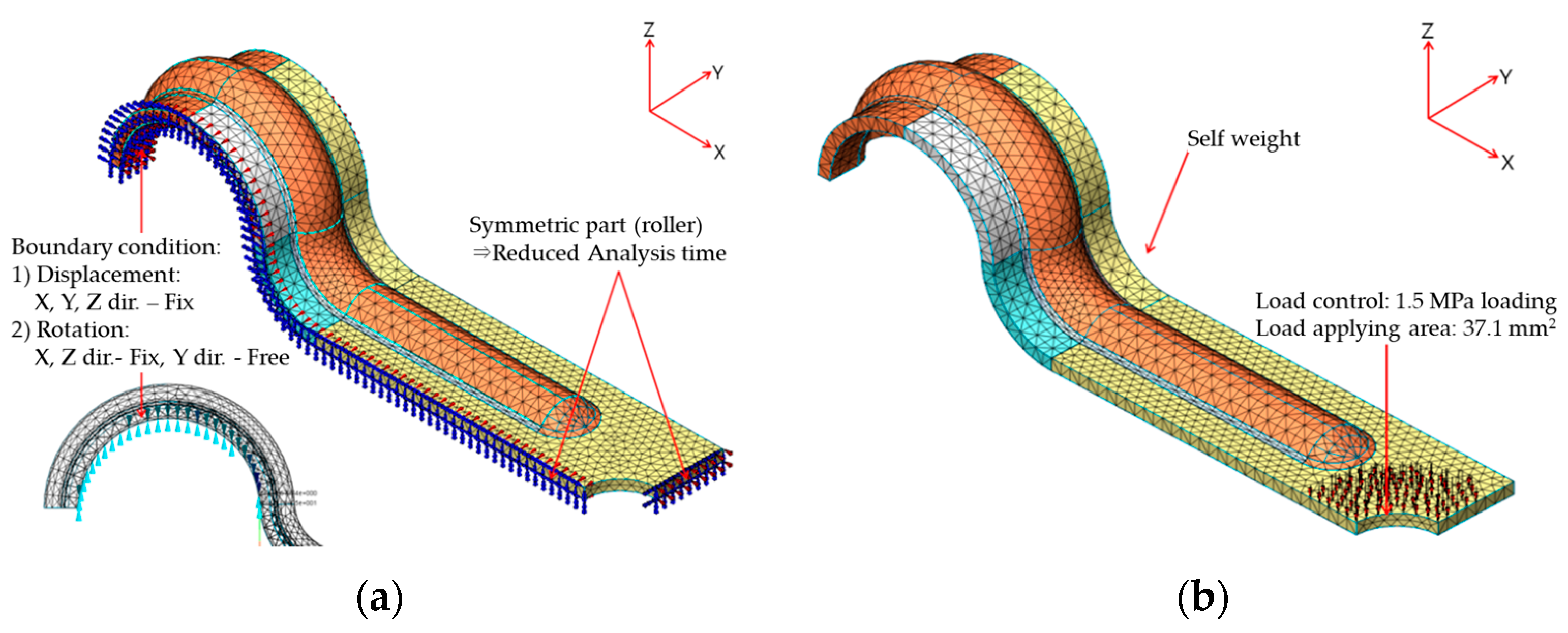
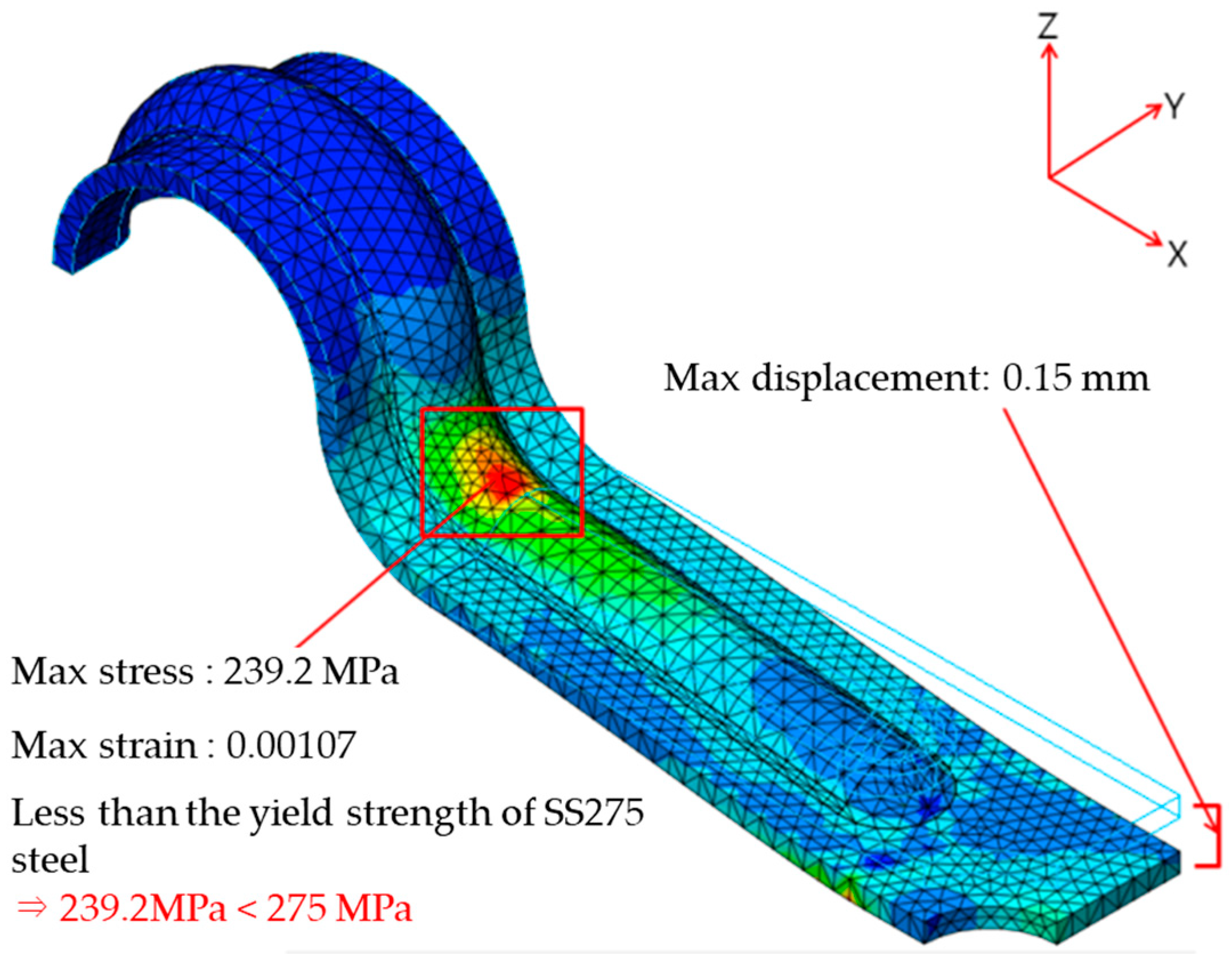


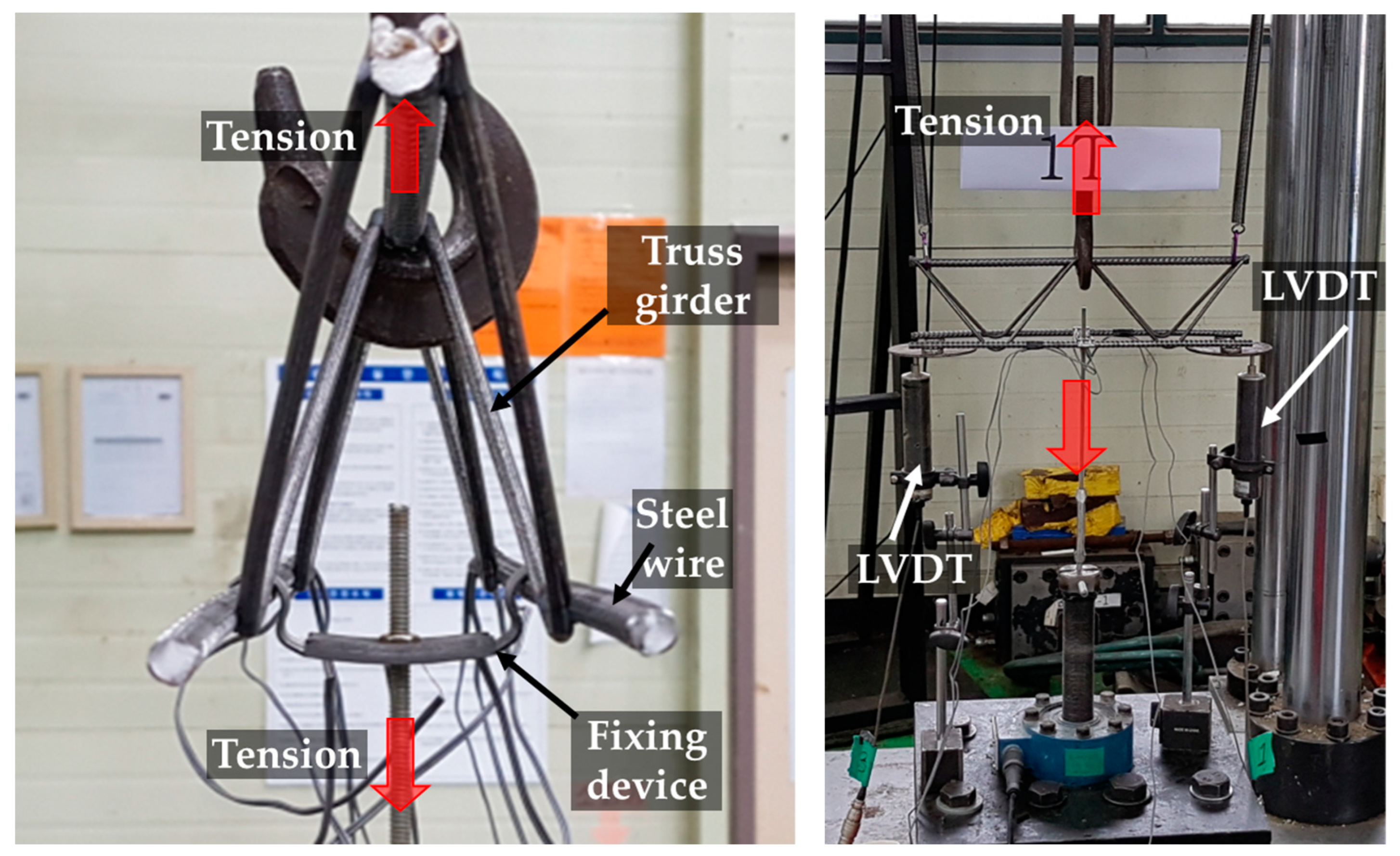

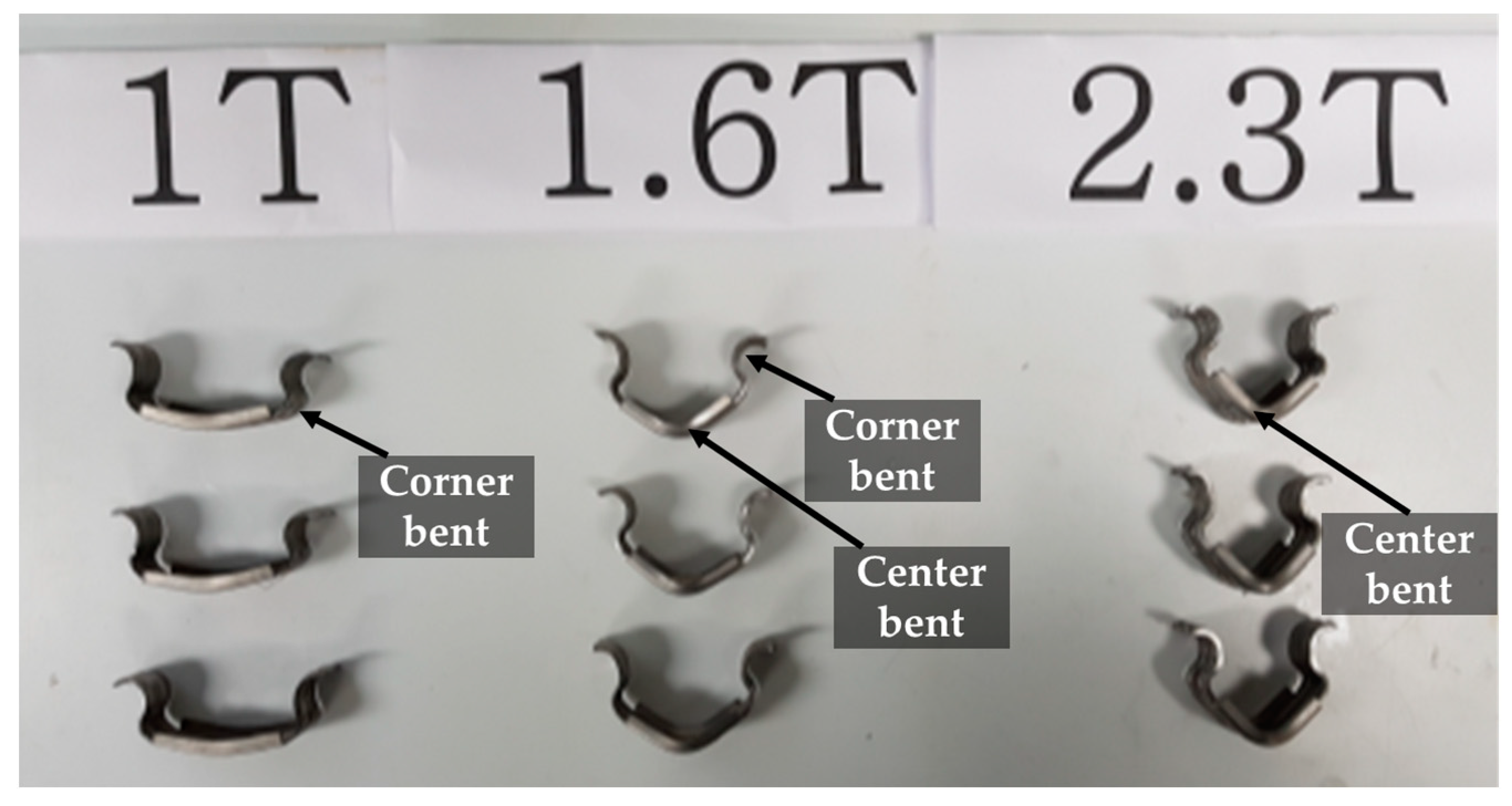
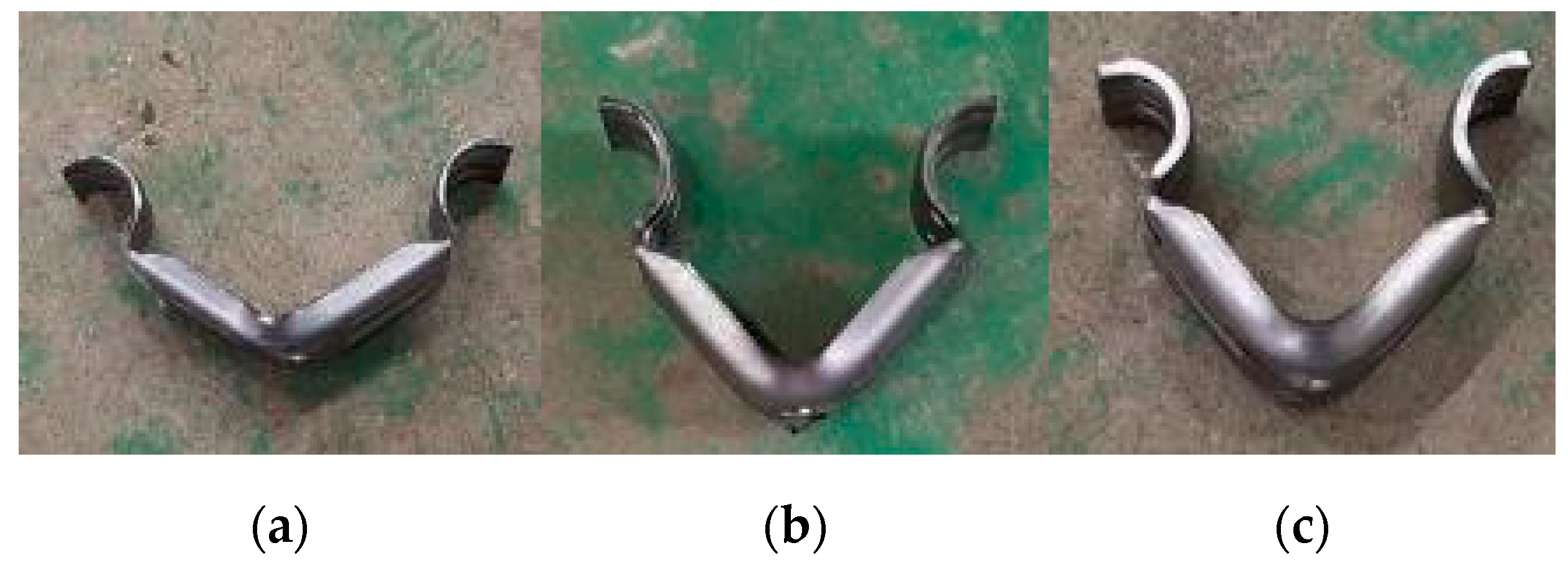


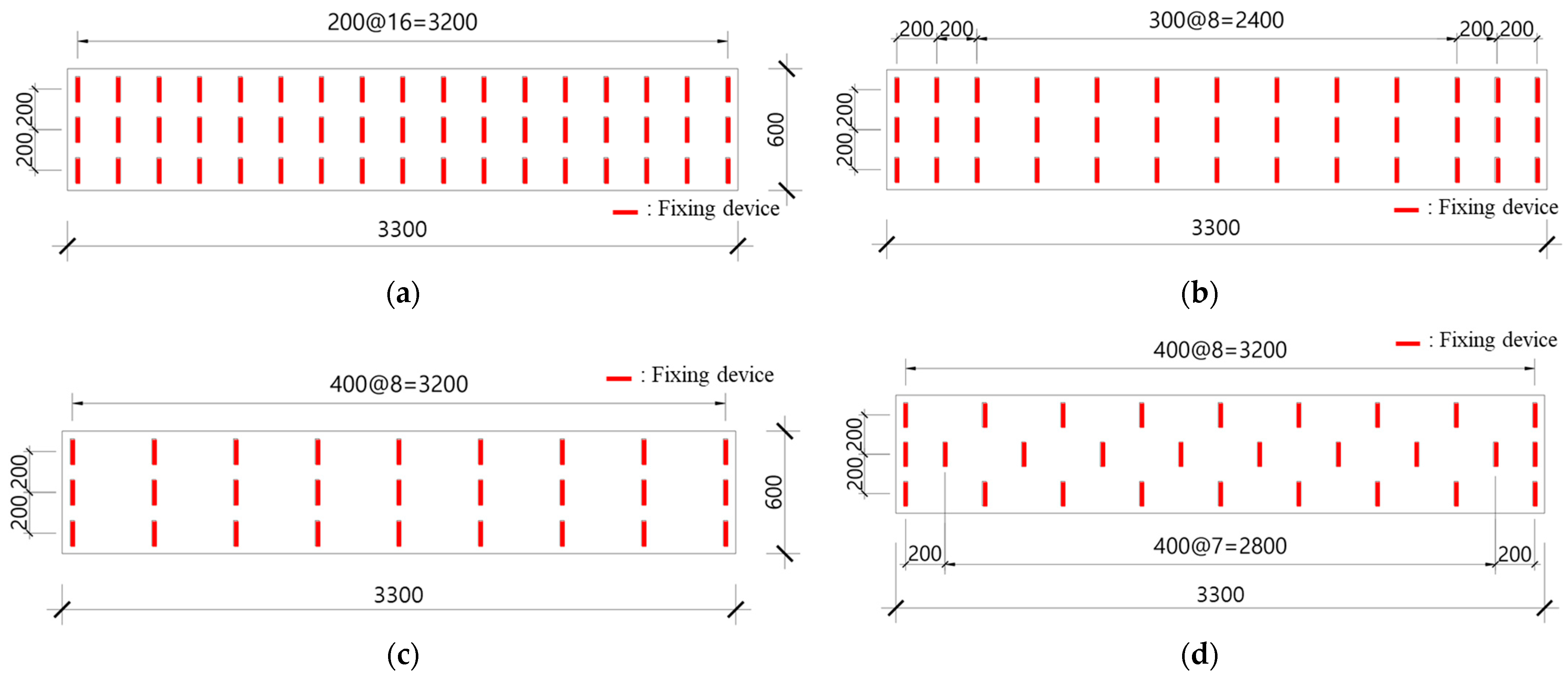




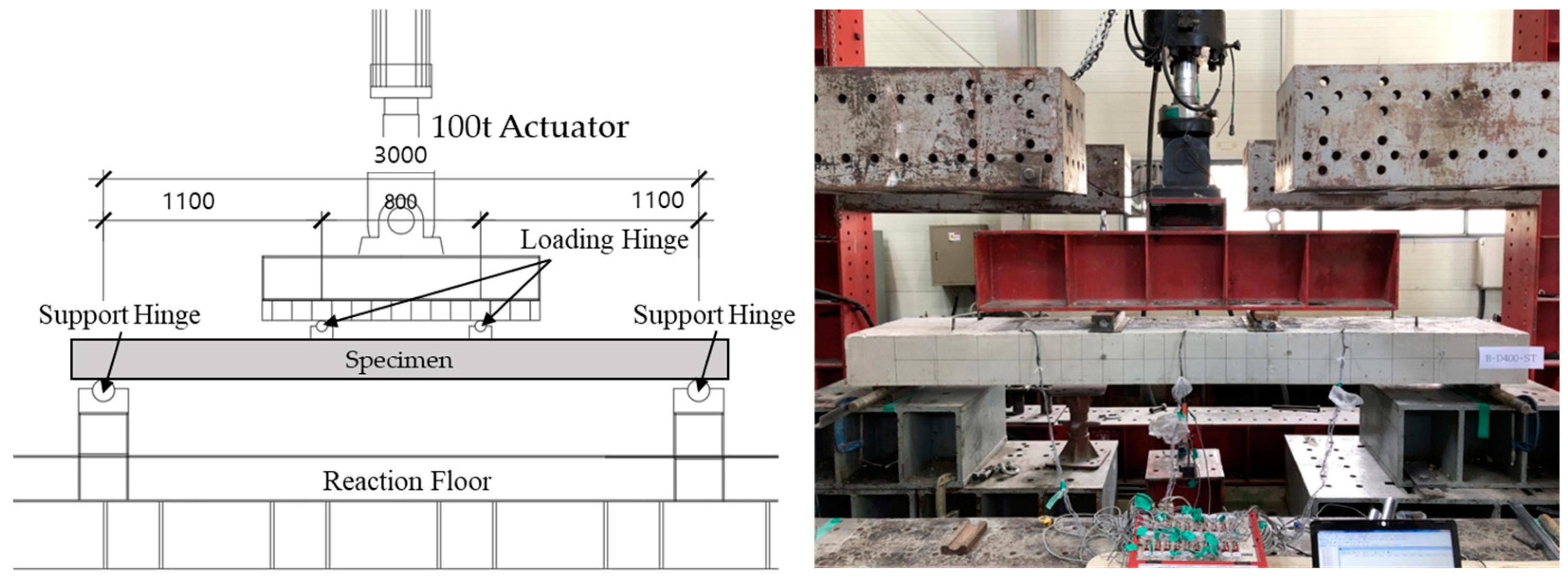

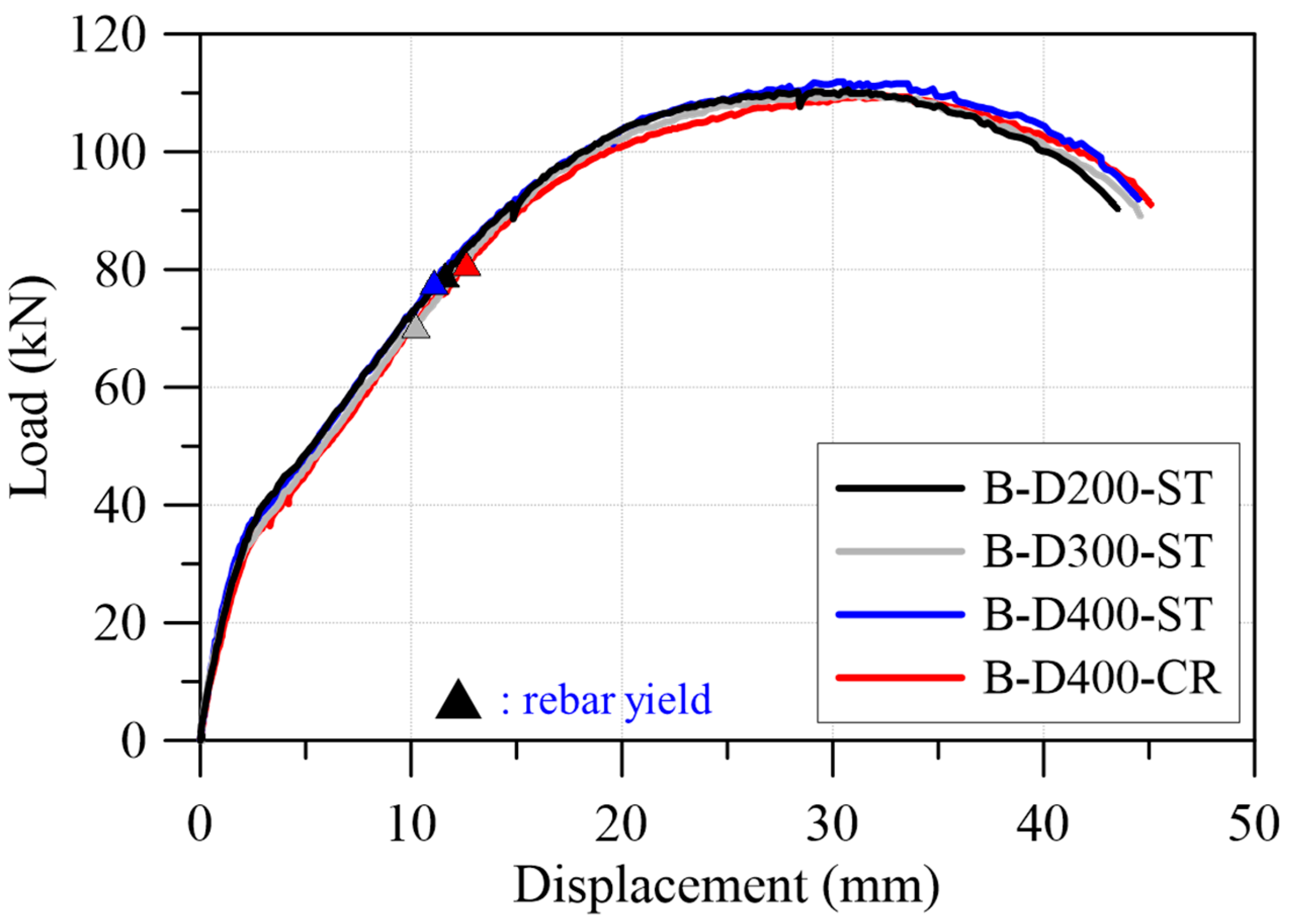

| Specimens | Thickness (mm) | Type |
|---|---|---|
| R-1.0T-1 | 1.0 | R (rib) |
| R-1.0T-2 | ||
| R-1.0T-3 | ||
| R-1.6T-1 | 1.6 | |
| R-1.6T-2 | ||
| R-1.6T-3 | ||
| R-2.3T-1 | 2.3 | |
| R-2.3T-2 | ||
| R-2.3T-3 | ||
| RP-1.2T-1 | 1.2 | RP (rib plus) |
| RP-1.6T-1 | 1.6 | |
| RP-1.6T-2 | ||
| RP-2.0T-1 | 2.0 | |
| RP-2.0T-2 | ||
| IR-1.6T-1 | 1.6 | IR (integrated rib) |
| IR-2.0T-1 | 2.0 |
| Specimen | Yield Load | Peak Load | |||
|---|---|---|---|---|---|
| Load (kN) | Displacement (mm) | Yield Position | Load (kN) | Displacement (mm) | |
| R-1.0T-1 | 0.48 | 12.35 | C | 0.78 | 20.18 |
| R-1.0T-2 | 0.35 | 7.95 | W | 0.78 | 22.8 |
| R-1.0T-3 | 0.32 | 8.51 | 0.78 | 22.5 | |
| R-1.6T-1 | 0.65 | 11.79 | C | 1.63 | – |
| R-1.6T-2 | 0.58 | 6.73 | 1.73 | 34.82 | |
| R-1.6T-3 | 0.6 | 8.54 | 1.72 | 34.8 | |
| R-2.3T-1 | 1.3 | 10.42 | C | 3.55 | 62.23 |
| R-2.3T-2 | 1.18 | 16.44 | 3.3 | 43.01 | |
| R-2.3T-3 | 1.25 | 11.8 | 3.32 | 45.39 | |
| RP-1.2T-1 | 0.59 | 12.15 | C | 0.86 | 27.44 |
| RP-1.6T-1 | 0.82 | 13.14 | 2.01 | 41.76 | |
| RP-1.6T-2 | 0.51 | – | 1.46 | – | |
| RP-2.0T-1 | 0.93 | 10.36 | 2.52 | 42.04 | |
| RP-2.0T-2 | 0.7 | – | 1.98 | – | |
| IR-1.6T-1 | 1.05 | – | C | 2.15 | – |
| IR-2.0T-1 | 1.54 | – | 3.84 | – | |
| Specimen | Spacing of Fixing Device (mm) | Fixing Device Installation Type |
|---|---|---|
| D200-ST | 200 | ST (straight) |
| D300-ST | 300 | |
| D400-ST | 400 | |
| D400-CR | 400 | CR (cross) |
| Specimen | Peak Load (kN) | (mm) | |
|---|---|---|---|
| D200-ST | 24.2 | 8.8 | 341 |
| D300-ST | 8.4 | 357 | |
| D400-ST | 11.9 | 252 | |
| D400-CR | 10.4 | 288 |
| Specimen | At Maximum Load | |
|---|---|---|
| Tensile Rebar | Fixing Device | |
| D200-ST | 0.00032 | 0.0004 |
| D300-ST | 0.00030 | 0.0009 |
| D400-ST | 0.0003 | 0.0013 |
| D400-CR | 0.00025 | 0.0017 |
| Specimen ID | Length | Width | Thickness | Shear Span Ratio | Spacing of Fixing Device | Fixing Device Installation Type | Deck Plate Type * |
|---|---|---|---|---|---|---|---|
| (mm) | (mm) | (mm) | (mm) | ||||
| B-D200-ST | 3300 | 600 | 250 | 4.4 | 200 | ST (straight) | D200-ST |
| B-D300-ST | 300 | D300-ST | |||||
| B-D400-ST | 400 | D400-ST | |||||
| B-D400-CR | CR (cross) | D400-CR |
| Specimen ID | Yield Point | Peak Load | ||||||
|---|---|---|---|---|---|---|---|---|
| Load (kN) | Disp. (mm) | Moment (kN-m) | Rotation (×10−2 rad) | Load (kN) | Disp. (mm) | Moment (kN-m) | Rotation (×10−2 rad) | |
| B-D200-ST | 89.4 | 14.8 | 49.2 | 1.34 | 108.4 | 30.7 | 59.6 | 2.79 |
| B-D300-ST | 81.6 | 11.9 | 44.9 | 1.08 | 107.6 | 29.4 | 59.2 | 2.67 |
| B-D400-ST | 84.4 | 13.2 | 46.4 | 1.20 | 109.7 | 30.2 | 60.3 | 2.75 |
| B-D400-CR | 92.8 | 16.8 | 51.1 | 1.53 | 107.4 | 32.6 | 59.0 | 2.96 |
Disclaimer/Publisher’s Note: The statements, opinions and data contained in all publications are solely those of the individual author(s) and contributor(s) and not of MDPI and/or the editor(s). MDPI and/or the editor(s) disclaim responsibility for any injury to people or property resulting from any ideas, methods, instructions or products referred to in the content. |
© 2023 by the authors. Licensee MDPI, Basel, Switzerland. This article is an open access article distributed under the terms and conditions of the Creative Commons Attribution (CC BY) license (https://creativecommons.org/licenses/by/4.0/).
Share and Cite
Jung, H.-S.; Yoo, M.; Choi, C.-S. Flexural Performance of Removable Deck Slabs with Fixing Device Details. Appl. Sci. 2023, 13, 4903. https://doi.org/10.3390/app13084903
Jung H-S, Yoo M, Choi C-S. Flexural Performance of Removable Deck Slabs with Fixing Device Details. Applied Sciences. 2023; 13(8):4903. https://doi.org/10.3390/app13084903
Chicago/Turabian StyleJung, Hyun-Suk, Mooyoung Yoo, and Chang-Sik Choi. 2023. "Flexural Performance of Removable Deck Slabs with Fixing Device Details" Applied Sciences 13, no. 8: 4903. https://doi.org/10.3390/app13084903






